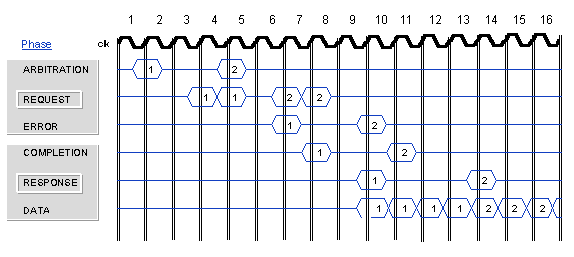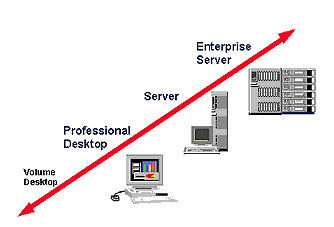SYSTEM BUS
BUS PROTOCO
SUMMARY
Using a Pentium Pro processor bus is like running this valet parking with 8 attendants all of whom can be servicing multiple, overlapped requests to fetch/park cars and guests will only have to wait a long time if more than 8 requests are made. A protocol must be defined so that cars do not collide at the single door into and out of the garage (simultaneous write and read are not permitted). Note too that the cars don't move any faster in the Pentium Pro processor garage, when compared with the Pentium processor garage, but they do move more efficiently. Imagine five cars being fetched and arriving bumper-to-bumper rather than five minutes between each one!
When one or more processors are capable of making multiple
requests a bus that is capable of servicing multiple requests is needed.
| TOP |

Bus transactions are divided into multiple overlapping
phases
All agents decide if they should respond and, if necessary, drive completion codes onto the bus during the completion phase. Other Pentium Pro processors (and a cluster bridge if present) will drive HIT# and HITM# during this phase so that the owner of the response can be determined. and HITM# during this phase so that the owner of the response can be determined. Note that an agent that cannot respond within the assigned four clocks should drive HIT# and HITM# to stretch the completion phase in increments of two clocks. Cache hits will allow a Pentium Pro processor to respond in preference to memory; cache-to-cache transfers are faster then memory transfers but memory must snarf the cache data on a HITM#.$
Referring to the chart above, multiple requests and
responses
can be seen on the bus at the same time. A logic analyzer looking at, say,
clock 14 will observe data from response 2, completion codes for response
3, request 4 started and request 5 arbitrating for use of the bus. Intel
is working with logic analyzer vendors so that their tools will contain
software that displays this array of 1's and 0's as discrete, time-coded
transactions.
![[Pentium Pro Processor System Bus]](sys1.gif)
Let's take our attention to a higher level now. Where does this design fit in a systems environment? This diagram looks essentially like a standard block diagram of a computer system except for the L2, which is in the same package as the CPU. The first thing to note is that when we got to this point in designing the Pentium Pro processor, we saw how to design a fast CPU, but if we left the rest of the machine alone we would have taken a relatively balanced system and unbalanced a piece of it.
The problem with an unbalanced system is you can't predict the performance. And generally it has unpleasant surprises in other ways. So we set out to explore what other things needed attention. That resulted in the following bus:

The Pentium Pro processor enables new classes of scalable
designs
TOP